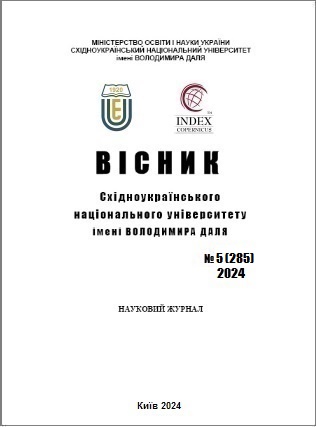Internet of things and artificial intelligence in agriculture
DOI:
https://doi.org/10.33216/1998-7927-2024-285-5-65-71Keywords:
Internet ofThings, Artificial Intelligence, AIoT (Artificial Intelligence of Things) concept, innovative technologiesAbstract
This article explores the role of modern technologies such as the Internet of Things (IoT) and Artificial Intelligence (AI) in the development of agriculture. This combination facilitates process automation, increases production efficiency, optimizes resource utilization, and improves product quality. Applications in crop cultivation and livestock farming are discussed, helping farmers make more informed decisions based on real data. The challenges and economic benefits of implementing IoT and AI in agriculture are analyzed, including the need for substantial investments and ensuring cybersecurity across various countries worldwide.
Technological advancements in agriculture meet the growing demands for farm automation, economic digitalization, and environmental sustainability. Current industry trends emphasize the transition to precision farming, which allows for more efficient use of time and resources, reduces production costs, and minimizes crop losses.
The integration of innovative solutions in agricultural management processes shifts the balance of influence in domestic markets, creating new opportunities for growth. Artificial intelligence technologies significantly enhance efficiency across various sectors, including agriculture, and address many pressing challenges. Agricultural robots designed for AI integration ensure the effective use of this technology in agribusiness.
In the context of rapid global population growth, agriculture faces numerous challenges, and the use of AI and IoT can become a key element in overcoming them. Despite high initial costs, which may deter some producers, investments in innovative technologies typically pay off within a few years, demonstrating their economic viability.
By utilizing IoT and AI technologies, the agricultural sector can produce more with fewer resources, improve product quality, and accelerate time to market. With IoT sensors, farmers can more accurately calculate the required volumes of water, fertilizers, and pesticides, reducing their consumption. The rational use of energy and natural resources lowers costs and minimizes environmental harm. Continuous monitoring of growing conditions (temperature, humidity, light levels) enhances crop quality and livestock productivity. AI helps predict diseases and implement preventive measures.
These technologies prevent crop losses caused by adverse weather conditions, pests, or diseases. Supply chain monitoring ensures better control over product storage and transportation. AI algorithms analyze large volumes of data to forecast yields, determine optimal planting and harvesting times, and provide farmers with precise decision-making recommendations. Precision farming systems reduce dependence on climate variability through accurate data and adaptive management methods. IoT and AI technologies contribute to increased yields and agricultural stability, addressing the challenges posed by global population growth.
The implementation of IoT and AI in agriculture not only improves the efficiency and competitiveness of the sector but also creates the foundation for the sustainable development of the agricultural industry. Key words: Internet of Things, Artificial Intelligence, AIoT (Artificial Intelligence of Things) concept, innovative technologies.
References
1. Gutierrez J. V., et al. Smart Agriculture: IoT, AI and Their Applications in Agriculture. Wiley, 2023. 320 p.
2. Lenniy D. Artificial Intelligence in Agriculture: Rooting Out the Seed of Doubt [Електронний ресурс] / Dmytro Lenniy // Intellia Karolinska Street 15 and 39, 04080, Kyiv, Ukraine. 2022. https://intellias.com/artificial-intelligence-inagriculture/.
3. Sandeep Kumar, Vikas Artificial Intelligence and Machine Learning in Agriculture. Kyiv: Naukova Dumka, 2021. 280 p.
4. Sharma, R. K., Singh, A. K. IoT in Agriculture: Innovation, Applications, and Challenges. Elsevier. 2022. 350 p.
5. Suresh Neethiraja. Artificial Intelligence and Sensor Technologies in Dairy Livestock Export: Charting a Digital Transformation. 2023. https://doi.org/10.3390/s23167045
7. Tahsin KN (2016) Development of a propeller P8X 32A based wireless biosensor system for cattle health monitoring and disease detection. British Journal of Applied Science and Technology 18(2), 1-14
8. Bondarenko D. A. Zastosuvannya tekhnolohiy internetu rechey v silskomu hospodarstvi. Telekomunikatsiyni ta informatsiyni tekhnolohiyi. 2022. №2(75).
9. Humenyuk, V. I., Kovalchuk, S. M. Internet rechey u silskomu hospodarstvi: tekhnolohiyi ta zastosuvannya. Kyiv: Agrarna osvita, 2021. 350 s.
10. Kyivstar biznes. Internet rechey u silskomu hospodarstvi. https://hub.kyivstar.ua/articles/efektyvna–robota–agrotehniky–za–dopomogoyu–iot–rishenhttps
11. Petrenko, O. M. Shtuchnyy intelekt u silskomu hospodarstvi: praktychnyy posibnyk. Lviv: Vydavnytstvo "Agroosvita", 2022. – 280 s.
12. Savchenko A. S. Metody ta systemy shtuchnoho intelektu: posibnyk. NAU: 2017. – 176 s.
13. Solona O. V., Skoromna O.I. Tekhnika, enerhetyka, transport APK. 2023. №4(123). s.43–50. http://tetapk.vsau.org/storage/articles/January2024/5gJoIndA33kbLIZav2WI.pdf
14. Propozytsiya. Holovnyy zhurnal z pytan ahrobiznesu. Big Data v velykykh hospodarstvakh. https://propozitsiya.com/ua/big–data–v–bolshih–hozyaystvah

